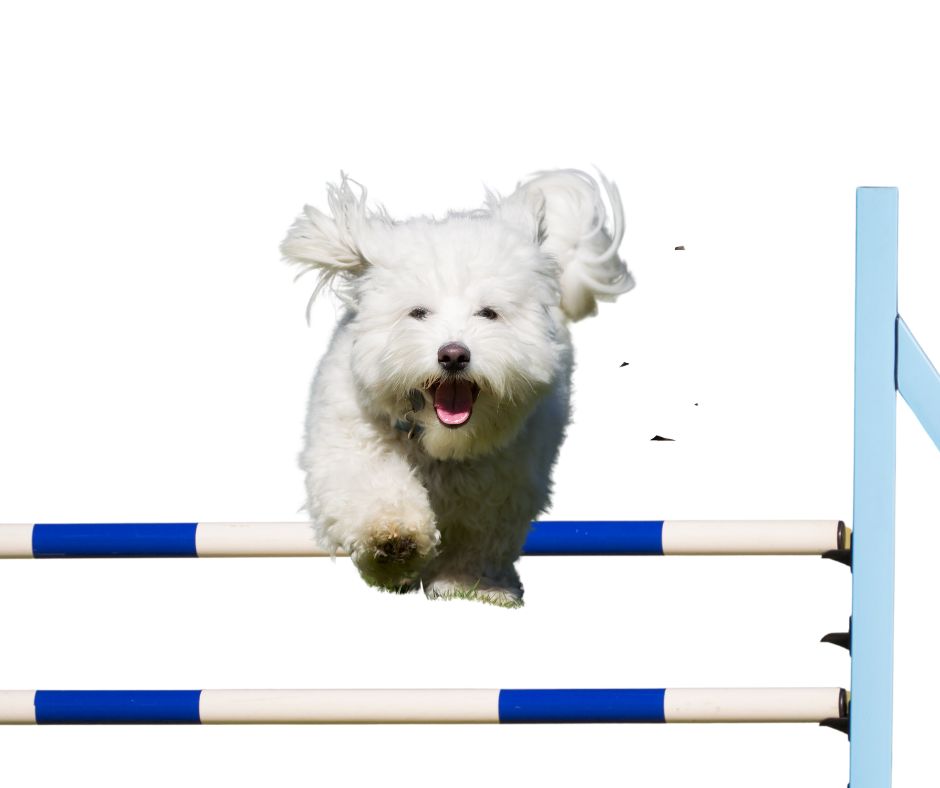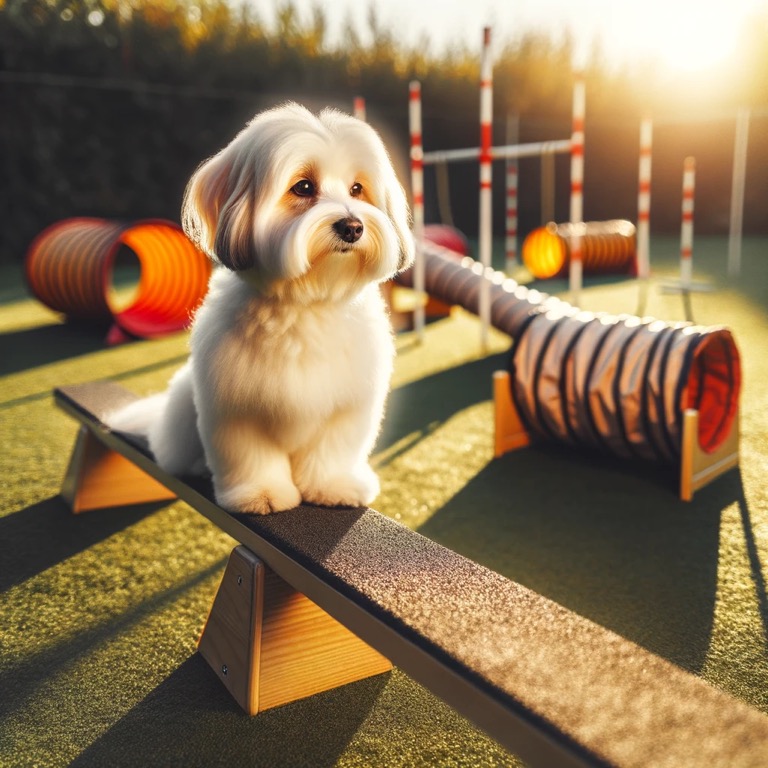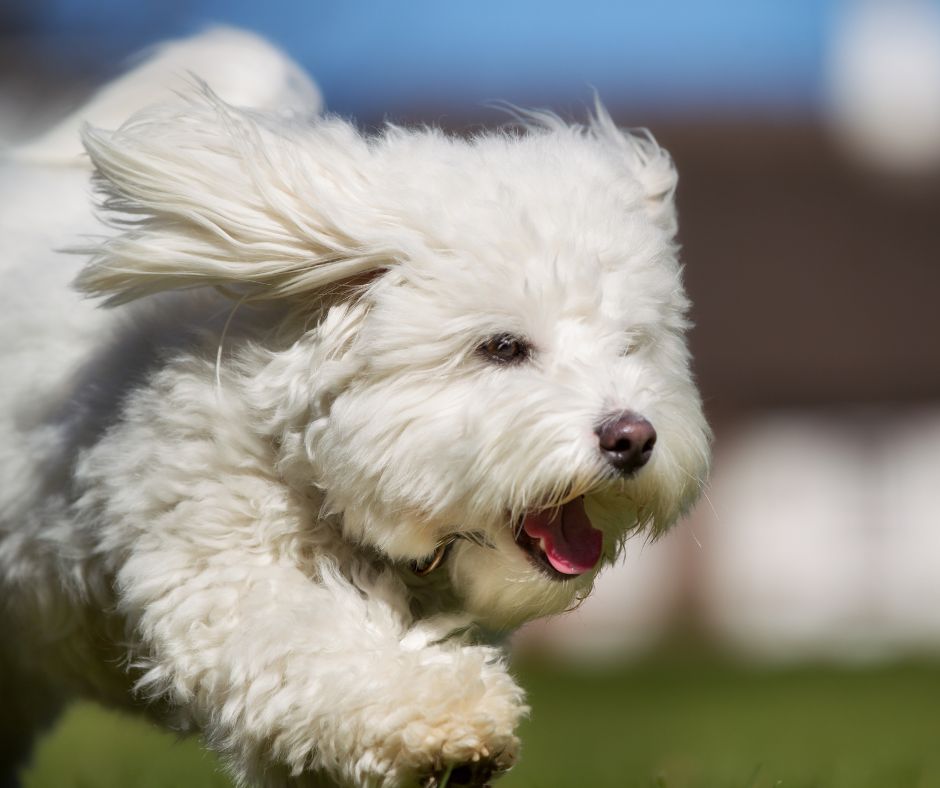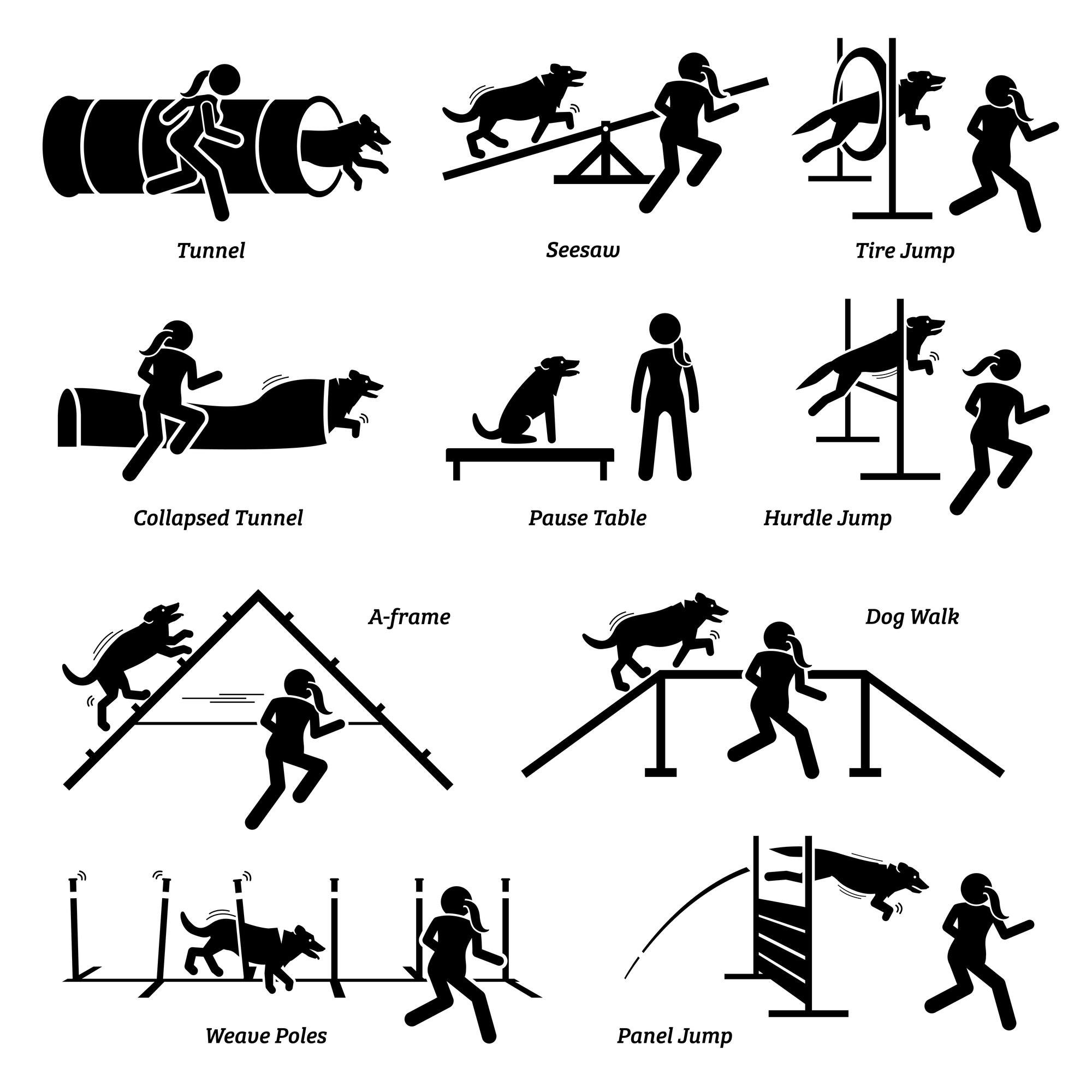Agility Training for Dogs: How to Get Your Coton Started
What is Agility Training for Dogs?
Agility training is a sport where you guide your dog through an obstacle course with various obstacles, including tunnels, weave poles, and jumps. It's best for fully grown dogs, starting no earlier than 12-18 months, and provides both physical exercise and mental stimulation.

Types of Agility Training
Competition dog agility is a fast-paced sport where handlers and their dogs compete at a high level for titles, rankings, and financial rewards. It requires hard work, a set amount of time, and dedication.
Backyard Agility (Just-for-fun) is primarily a recreational activity that provides great exercise, mental stimulation, and bonding between dog and owner.
Backyard agility training isn’t so much a race against the clock or another dog, as much as it’s a great way to bond, provide lots of exercise, and have a good time together.
All dogs, including small breeds like the Coton de Tulear, can participate in agility training regardless of breed or size.
For this article, I’m focusing on how to get started with agility, which is geared toward just-for-fun agility training for dogs.
What are the benefits of dog agility training?
Whether you’re just starting out or competing at an advanced level, agility is one of the best ways to exercise your dog, as you can see from this list of benefits:
- Provides exercise that enhances their health and vitality
- Enhances communication between you and your dog through voice commands and body language
- Improves bad dog behavior; a bored dog will find all kinds of ways to get into trouble
- Improves balance and coordination, boosting your dog’s confidence
- Builds a stronger bond between you and your dog
- Most importantly, it’s fun for both you and your pup, making it the best way to spend time together as you both learn new skills

Coton de Tulear Agility: Is the Coton a Good Candidate for Dog Agility Training?
The short answer is YES!
Coton de Tulear dogs are excellent agility participants because they:
- Are speedy
- Have the desire to please
- Are smart and are easy to train with positive reinforcement
- Have excess energy (Zoomies anyone?)
- Like to be active
- Love spending quality time with their owners
- Are in sync with their owners, body language and hand signals are key in this sport
- Love having fun and a happy dog is a benefit of agility
Want to see an example of this agility training in action? Watch this Coton de Tulear have fun on this super simple backyard agility course.
https://youtu.be/1AKvAH547kE?si=RLYxAWUdy60EDEN2Coton de Tulear Exercise Needs: How Much Physical Activity is Necessary?
I hear from some Coton parents that their dogs are couch potatoes. They like to sleep all day or cuddle on the couch with their people. If you were to see Lucy at home, she could definitely be described as a couch potato.
But if you give her a task to do or an open field, she's full of energy and can outrun just about any dog she sees. Sometimes, our dogs just need to be given the opportunity to try something new and fun.
And the bottom line is that ALL dogs need exercise for optimum health - even our beloved couch potatoes.

7 Things You Need to Know Before Getting Started with Agility Training
No. 1 - Assessing Your Dog's Fitness
Is your dog up to the challenge of the agility course?
Physical Check-Up: Consult a veterinarian to ensure your dog is physically fit for agility training.
Age Factor: In general, dogs less than a year old or senior dogs with joint issues should not participate.
Temperament: This sport is excellent for dogs who are responsive to commands, and have a willingness to work. Cotons are notorious for wanting to please their humans, so their temperament is a good fit for agility.
No. 2 - Basic Obedience Commands are a Prerequisite
Basic Skills Your Dog Should Know Before You Start
- Basic commands like "Sit," "Stay," and "Stop" are a must for safety and are invaluable for controlling your dog in various situations. They can prevent your dog from running off course, colliding with obstacles, or even getting into potentially dangerous situations.
- Commands like "Come," "Go," "Over," and "Under" are not just instructions but a language that creates a dialogue between you and your dog. Understanding basic commands can significantly speed up the learning process when introducing agility-specific instructions. Think of it like learning the alphabet before you start forming words and sentences; it's foundational.
- Obedience training is not just about control but communication and trust. When your dog follows a command correctly, especially in the stimulating environment of an agility course, it's a sign that they trust your guidance. This trust is the cornerstone of a deeper bond between you and your dog.
Need a refresher? Learn more about basic training here

No. 3 - Understanding the Time Commitment
How long does it take to train an agility dog?
The amount of time you need to invest in training your dog for agility can vary depending on several factors, including your dog's age, prior training, temperament, and personal goals.
Here are some considerations:
- Age of Your Dog: If you start training a puppy, you may need several months to introduce basic obedience commands and build a foundation for agility. Older dogs with prior training may progress more quickly.
- Consistency: Consistency in training is essential. Regular, short training sessions (around 15-20 minutes) several times a week are more effective than infrequent, long sessions.
- Foundation Training: Initial foundation training can take a few months to teach your dog essential skills like obedience commands, recalls, and impulse control. These skills form the basis for agility training.
- Agility Skills: Teaching specific agility skills like jumps, tunnels, weave poles, and contacts can take additional months. The complexity of the course elements you want to train your dog for will influence the time required.
- Advanced Training: Advanced training, including handling techniques and course sequences, can take a year or more to master. This is when you and your dog start working as a team to navigate full agility courses.
- Consolidation: Continuous practice and refinement are necessary to maintain and improve your dog's agility skills. Ongoing training sessions and participation in agility classes or events will help you both grow.
- Individual Progress: Dogs vary in their learning pace. Some dogs may progress quickly, while others may need more time to grasp certain skills.
No. 4 - Do dogs like agility training?
Many dogs, including Cotons, have a knack for this sport. But remember, every dog is an individual with its own unique personality and preferences.
Before diving headfirst into building a backyard agility course, why not dip your toes in first? Attending a local agility class is a fantastic way to get a taste of the action. You'll grasp the fundamentals and, more importantly, gauge whether your Coton is as excited about weaving poles and jumping hoops as you are.
Agility can be an exhilarating bonding experience for you and your dog. Yet, it's crucial to keep an eye on their reactions. Are they leaping with joy or dragging their paws? If they seem overwhelmed or disinterested, don't force it. There's a world of activities to explore that better align with their interests.
Remember, your Coton often mirrors your emotions. If you approach training enthusiastically and keep sessions lively and brief, there's a good chance they'll be wagging their tail in excitement alongside you!
This post contains affiliate links. For more information, read my disclosures here.
No. 5 - Learn how to teach dog agility
Many resources are available for building an agility course for beginning your journey in the sport. Here are just a few:
- Dog agility videos - YouTube is always a free and fun way to learn
- Dog agility resources for equipment, such as the United States Dog Agility Association (USDAA) or the American Kennel Club (AKC).
- SpiritDog Agility Class: It can be overwhelming when you start learning everything involved with this sport. Spiritdog is a fantastic resource for beginners. They walk you through everything you need to know, including how to build your own equipment. And they are there to guide you if you have questions. They take the guesswork out of the process so you can make training fun for you and your dog.
- Agility training clubs
- Local training classes
No. 6 - Dog Agility Training Equipment Needed
If you’re going to create your own agility course, you’ll need the following essential basic equipment. Remember, if you’re doing this for fun in your backyard, you can pick and choose which equipment makes sense for your dog and the size of your yard.
Starter kits are usually more affordable than buying each piece of equipment separately. And DIY equipment is even more affordable.
SpiritDog is a great resource for building your own equipment.
Pet Pro Supply Company has a supply of agility equipment from top brands.

Dog Agility Equipment:
Jumps (Bar and Panel): Jumps train your dog to jump over barriers at varying heights. It enhances leg strength and improves timing.
DIY Option: PVC pipes can be used to build adjustable jumps.
Agility Tunnel: Tunnels train your dog to run through confined spaces. It helps boost confidence and provides variety in training.
DIY Option: Alternative alternatives include flexible drainage pipes or children’s play tunnels.
Weave Poles: These poles help teach your dog to slalom through a line of vertical poles. It enhances coordination and teaches precision.
DIY Option: Slalom ski poles or PVC pipes planted into the ground.
A-Frame: Your dog learns to climb up one side and down the other of an A-shaped structure. This activity helps build strength and confidence. But it requires a lot of space and is one of the more expensive pieces of equipment to purchase.
DIY Option: Two sturdy boards hinged together, with a non-slip surface applied.
Pause Table: A pause table trains your dog to stop and settle on a table for a set amount of time. This pause teaches control and patience and provides a break in the action.
DIY Option: A low, sturdy table with a non-slip surface.
Dog Walk: A dog walk is a narrow plank for the dog to walk along, elevated off the ground. It helps enhance balance and focus. DIY is much more affordable than purchasing online, but make sure it’s safe!
DIY Option: Long, flat boards with supports and a non-slip surface.
Tire Jump: A tire-shaped object is suspended in a frame that the dog jumps through. This adds variety and improves jumping accuracy.
DIY Option: An actual tire hung from a sturdy frame.
No. 7 - Affordable Agility Training: How much does dog agility cost?
The cost of dog agility training can vary depending on several factors, including the location, the trainer's experience, and the level of training you're seeking.
Here's a breakdown of the typical costs associated with getting started in dog agility training:
Private lessons: Private agility training lessons can range from $20 to $70 per half-hour session. The cost varies depending on the experience level of the trainer.
Group classes: Joining group agility classes can be a more affordable option. Prices for group classes can vary widely, but you might expect to pay anywhere from $50 to $150 for a multi-week course. My dog, Luc, took lessons at our local Humane Society. It was under $100 for a six-week beginner class.
Equipment: If you plan to train at home, you'll need agility equipment. The average cost of agility equipment is around $1,000, with individual obstacles ranging from $30 to $1,600. Yikes!
You can save money by building your own equipment. There are dog agility equipment starter kits for the backyard dog agility course, or you can even make your own perfect obstacle course with PVC pipe.
Travel and competition costs: If you decide to compete in competitive agility events, you'll need to budget for travel expenses, entry fees, and other associated costs. Keep in mind that many people participate in agility for the passion and not necessarily for monetary gain.
Of course, these are general price ranges, and actual costs can vary based on location and specific training needs. For an accurate estimate, I recommend contacting local trainers and agility clubs in your area for pricing details.
Ready to Compete?
Are you ready to take your dog’s agility to the next level? Is your dog ready to compete?
According to the AKC, your dog must meet the following criteria:
- Must be at least 15 months old
- Your dog must be registered. Learn more here
- Only spayed or neutered dogs are eligible
- Up-to-date vaccines and in good health
Just starting out? check out these dog agility books for more information.
Return to Beyond Basic Dog Training
Home | About Me | Contact Me | Privacy Policy |Disclosure
Copyright© 2008- All Rights Reserved








